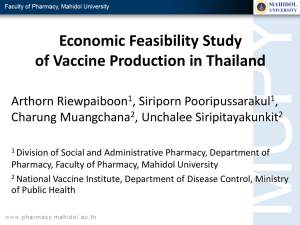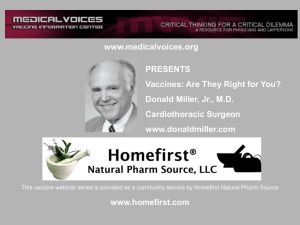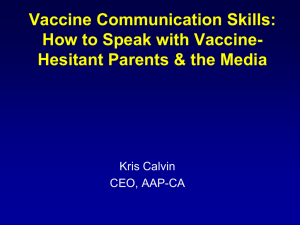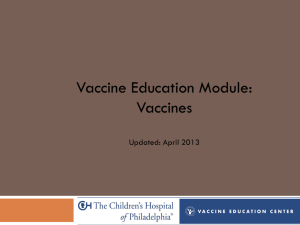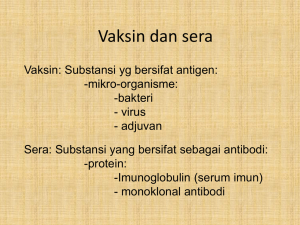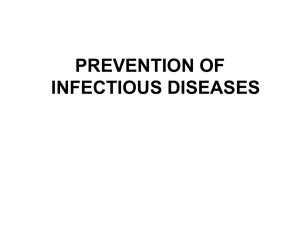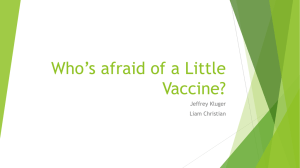33: Immunizations PowerPoint
advertisement
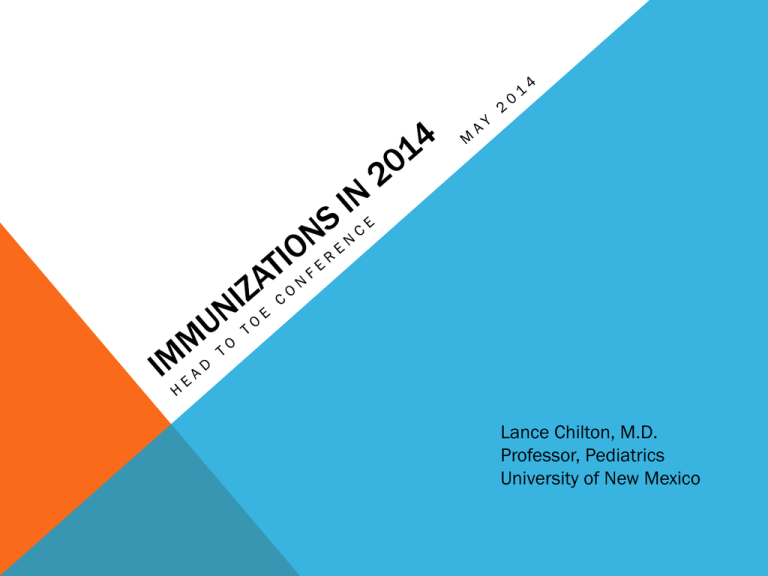
Lance Chilton, M.D. Professor, Pediatrics University of New Mexico THE REASON WE IMMUNIZE Achievements in Public Health, 1900-1999 Impact of Vaccines Universally Recommended for Children -- United States, 1990-1998 At the beginning of the 20th century, infectious diseases were widely prevalent in the United States and exacted an enormous toll on the population. For example, in 1900, 21,064 smallpox cases were reported, and 894 patients died (1). In 1920, 469,924 measles cases were reported, and 7575 patients died; 147,991 diphtheria cases were reported, and 13,170 patients died. In 1922, 107,473 pertussis cases were reported, and 5099 patients died (2,3). Dramatic declines in morbidity have been reported for the nine vaccine-preventable diseases for which vaccination was universally recommended for use in children before 1990 (excluding hepatitis B, rotavirus, and varicella) . Morbidity associated with smallpox and polio caused by wild-type viruses has declined 100% and nearly 100% for each of the other seven diseases. MMWR, April 2, 1999 Q: WHAT IS STILL THE MOST COMMON VACCINEPREVENTABLE DISEASE? A: INFLUENZA AKA: “JUST THE FLU” Average Annual United States Incidence of Influenza Outcomes Under 5 Years 5-17 Years Total Population “Just sick” 2,030,000 3,296,000 12,414,000 Outpatient visit 1,741,000 1,535,000 7,282,000 54,343 2,805 195,776 142 43 21,282 Hospitalized Deaths Molinari et al. Vaccine 25 (2007) 5086–5096 INFLUENZA DEATHS IN CHILDREN NEW MEXICO’S SCHOOL KIDS’ INFLUENZA IMMUNIZATION PROJECT X X XX X X X X X X X X X X X X X X X X X XX X X X X X X X X X X X X X XX XX X X X X X XX X X X X X KUDOS TO SKIIP AND TO ALL OF YOU! Flu Vaccine in Kids 80 60 US New Mexico 40 20 0 Age 5-12 All Under 17 0 100 200 300 400 500 EARLY ALBUQUERQUE DATA: FLU SCHOOL ABSENCES 0 10 20 30 40 50 week week_Full_Day_IL total_flu week_Half_Day_IL Gurule, Escareno, Dharas, Pentler, Skipper and Chilton, unpublished WHERE DO IMMUNIZATION RECS COME FROM? • American Academy of Pediatrics Committee on Infectious Diseases (Red Book Committee) : meets twice a year, produces Red Book every 3 years • ACIP – Next Meeting: June 25-26, 2014, Atlanta • Informational items • Votes RED BOOK COMMITTEE Podium Screen for Powerpoints Head Table M L Audience ACIP Members Liaisons Audience M L Audience ACIP Products www.cdc.gov/vaccines ARE VACCINES SAFE? AND WHAT’S VAERS ANYWAY? Vaccine Adverse Effects Reporting System VSD THE VACCINE SAFETY DATALINK This is the most robust vaccine safety system; there are others (example: military). THE ROTASHIELD® STORY (BORN 1998, DIED 1999) • Rotavirus kills some 450,000 children per year around the world; 20-60 in the United States • Early 1990s , clinical trials showed 80-100% effectiveness against severe rotavirus diarrhea and excellent safety profile • 1998: RotaShield licensed • Late 1998: reports to VAERS of many cases of intussusception after RotaShield receipt • VAERS Signal reported to VSD, which affirmed the hypothesis that RotaShield associated with intussusception • 1999: Rotashield removed from market. • Early 2000s, clinical trials on far more children showed no association with intussusception for two new vaccines, Rotarix® and Rotateq® • 2006: Rotarix and Rotateq approved by FDA and recommended by ACIP SUCCESS OR FAILURE OF THE VACCINE SAFETY SYSTEM? PENN AND TELLER’S APPROACH TO VACCINE SAFETY DISCUSSION Viewer Discretion Advised PAUL OFFITT’S APPROACH DR. BOB SEARS’ APPROACH DR. SEARS’ VACCINE SCHEDULE TOO MANY ANTIGENS? 2012: 2 month shots: Streptococcal Infection = Antigens: 25-50 antigens Rotavirus 5 Pediarix Diphtheria Tetanus Pertussis Polio Hepatitis B 1 1 3 3 1 H. Influenzae B 1 Pneumococcal 13 Total 28 In the old days: Smallpox vaccine = ~200 antigens Upper respiratory infection = 4-10 antigens Whole cell pertussis vaccine = ~3000 antigens DECLINING NUMBER OF ANTIGENS: But no, folks, you won’t have to pay for vaccines in New Mexico (yet). IN 42 STATES… But only for • Uninsured • Native Americans/Alaska Natives • Medicaid insured • Underinsured • But only in FQHC or RHC IN 6 STATES (NH, RI, VT, WI, WY AND… NEW MEXICO!) For all children and adolescents before their 19th birthday Alaska, Hawaii, Maine, Massachusetts, South Dakota, Washington cover most but not all childhood vaccines ARE THESE VACCINES AFFORDABLE? In Arizona, Colorado, Utah, Texas and most other states, the total private sector price of all vaccines for each person (except influenza) through age 18 was $2171 + vaccine administration as of April 2014. In New Mexico, the price to patients is $0 + vaccine administration Vaccines for Children for everyone in New Mexico is under attack! WHY IS THIS IMPORTANT? Vaccines for the first five years Vaccine Doses Total Pediarix 3 $211 Rotateq 3 $226 Hib 4 $93 Pneumo 4 $543 MMR 2 $112 Varivax 2 $188 Hep A 2 $61 DTaP 2 $21 Polio IPV 1 $27 TOTAL $1482 April 1, 2014, CDC data Vaccines for adolescence Vaccine Doses Total Gardasil 3 $425 Menactra 2 $226 Tdap $38 TOTAL 1 $689 Vaccine Total Cost per Child $2171 plus Influenza Vaccine, $8-23/dose IS IT WORTH IT? FIGURES FOR ONE BIRTH COHORT – 2009: 4.26 MILLION BIRTHS Disease Cost:benefit ratio Direct costs only: 3.0 Total societal costs: 10.1 Deaths Prevented Cases Prevented Direct Costs Saved, Million $ Societal Costs Saved (Direct + Indirect), Million $ Diphtheria 275 028 27 503 3654 39 296 Tetanus 169 25 12 45 Pertussis 2 950 836 1062 4443 7017 Hib 19 606 741 1810 3756 Polio 67 463 800 2898 7259 Measles 3 835 825 3106 3762 8862 Mumps 2 312 275 12 1411 2374 Rubella 1 981 066 15 187 721 Congenital rubella syndrome 632 70 133 257 HepB 239 993 3514 240 1770 Varicella 3 942 546 73 373 1598 HepA 153 164 36 52 114 Pneumococcusrelated diseasesb 2 323 952 5056 965 2696 Rota 1 582 940 19 327 595 Total 19 685 495 42 032 20 267 76 360 DEATHS THAT’S $20 BILLION and $76 BILLION! Zhou F et al. Economic Evaluation of the Routine Childhood Immunization Program in the US, 2009. Pediatrics, 2014. 133:577. RESULTS… VFC VACCINE VACCINE for everyone else $90,000 THIS IS WHY WE DO IT… Disease Annual Cases – Pre-Vaccine Era Annual Cases Since Vaccine Percent Reduction Diphtheria 175,885 0 100% Tetanus 1314 28 98% Measles 503,282 43 99.9% Mumps 152,209 800 99.5% Rubella 47,745 12 99.9% Congenital Rubella Syndrome 823 0 100% Polio 16,316 0 100% Haemophilus influenzae b 20,000 54 99.7% HOW’RE WE DOING ON INDIVIDUAL ADOLESCENT VACCINES? 90 80 70 60 50 40 30 20 10 0 90 80 70 60 50 40 30 20 10 UK HOW DO THEY DO THAT? NM Vaccines for ChildrenUS for everyone in New Mexico is under attack! ? CDC 2012 NIS data in MMWR, Aug. 30, 2013 CERVICAL CANCER IN NEW MEXICO New Mexico Tumor Registry, 2006-2010 data Incidence Race/Ethnicity Age-adjusted rate Average number of new cases Percent of all new cases Rank among all new cancer cases† NM, Non-Hispanic White 6.5 32 1.3% 13 NM, Hispanic NM, American Indian NM, Black NM, All Races Combined 9.0 6.5 5.2 * 35 6 1 76 2.8% 2.7% 2.0% 1.9% 10 13 11 * US, All Races Combined§ 7.4 11,070 1.6% 13 Mortality Race/Ethnicity Age-adjusted rate Average number of cancer deaths Percent of all cancer deaths Rank among all cancer deaths† NM, Non-Hispanic White 1.7 10 1.1% 15 NM, Hispanic NM, American Indian NM, Black NM, All Races Combined 3.1 3.5 * 12 3 - 2.6% 3.5% - 12 10 - 26 1.7% * US, All Races Combined§ 2.4 3,870 1.4% 14 Prevalence of individual human papillomavirus (HPV) types among females aged 14–19 years, 2003–2006 and 2007–2010. Markowitz L E et al. J Infect Dis. 2013;208:385-393 Published by Oxford University Press on behalf of the Infectious Diseases Society of America 2013. H P V V A C C I N AT I O N D O E S N O T C A U S E T E E N AG E R S TO H AV E S E X Mayhew A et al. Sexual Behaviors after HPV Vaccination. Pediatrics, 2014. 133:404. SHOULD WE GIVE MORE VACCINES IN NEW MEXICO SCHOOLS? Yes No • That’s where the • School nurses kids are! already have too many tasks • We could teach about the • Some vaccines diseases are too prevented controversial THANK YOU FOR ALL YOU DO! "Schools have a wealth of potential for ensuring the future well-being of young people. You can't educate a child who isn't healthy, and you can't keep a child healthy who isn't educated." -- M. Jocelyn Elders, MD
